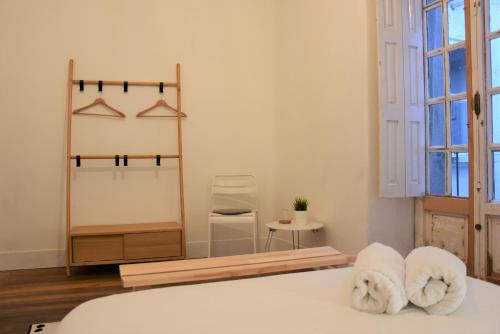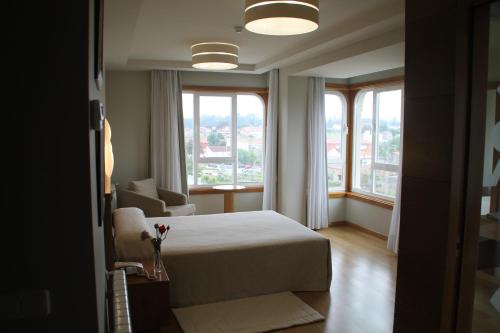Rias Baixas wine, Galicia, Spain
For centuries, the Spanish have grown grapes in the fertile soils of Galicia, the beautiful northwestern part of the country. Go back to the 1600s or 1700s and you’ll find the local wines exported across Europe, enjoyed by nobility and commoners alike.
Until the mid-19th century, that is.
It was then that much of Western Europe’s vineyards were wiped out by the ‘Phylloxera epidemic’, commonly known as the ‘Great French Wine Blight’. It was caused by plant-eating aphids accidentally being brought across the Atlantic from North America.
Most countries and regions recovered relatively soon, but not Galicia… particularly in the Rias Baixas region.
At the start of the 1900s, the local producers tried to accelerate their economic revival by planting cheaper hybrid vines and easily available grapes from other areas.
It didn’t work and in the 1970s, the farmers had to start again. But this time they were smart. They planted native grape varieties, with a special emphasis on a dry white called Albariño.
Since then, everything has only strengthened and the Rias Baixas in Spain has become one of the most important wine regions in Europe.
The O Salnes wine district
The Rias Baixas – named for the four large estuaries that flow in from the coastline (‘ria’ means ‘estuary’ in Spanish) – has become a popular tourist destination. It’s partly for the food, partly for the beautiful landscapes, and also for the wine, of course.
Within the Rias Baixas, we can break up the region into five distinct districts. Let’s focus today on just one of them – O Salnes – the oldest district and the birthplace of the Albariño grape.
From a wine perspective, not only is O Salnes the most important, but it is also the best for visitors. I want to give you a bit of information about how best to experience the local wines of the area.
Tasting the Albariño
The Rias Baixas district is a Denomination of Origin (DO), which means an area where the quality of the product is regulated and the wine can’t be sold if it’s not good enough. It’s similar to an appellation in France and it’s a big deal.
Although there are 12 grape varieties that can be sold under the regulations, 96 per cent of the plantings here are Albariño.
It’s why you come to Rias Baixas for wine tasting – to try this special grape in its natural setting.
The Albariño is dry and aromatic with all sorts of wonderful fruity flavours like peach, apricot, melon, pineapple and mango. All through the DO you’ll find that the wine is pale golden lemon, crisp , elegant and fresh.
In O Salnes, I particularly notice the melon character of what I try.
Good wineries for tasting
I tried four different wineries on my visit to O Salnes and I would recommend each of them. What you get with these four is variety. Each has its own unique style and its own special characteristics – in both venue and wine.
I have marked the four I am about to talk about as red on the map below. I have marked the other 32 wineries in the district as blue.
Adega Eidos
At the south of the O Salnes district, Adega Eidos has its own microclimate and creates a wine with a great balance of acidity and sugar.
It makes three main wines that you can taste – one of them is used in First Class on British Airways (which is the kind of thing that impresses me!).
The oldest vines that are used here are about 70 years old, which is impressive for the area (if you remember me mentioning how many of the new Albariño vines were planted from the 1970s).
You can do a tour here and see some of the vines. Notice how they are tired up on wire trellis systems to keep them away from the ground to protect the grapes against disease and dampness. This is the traditional (and common) method here in O Salnes.
Pazo Baion
One of the most beautiful settings for a winery in O Salnes is here at Pazo Baion. The grand gate has Adam and Eve statues on either side and a long driveway down to the main building – a 15th century castle.
It’s perhaps no surprise that it all looks so opulent when you discover the history. It was once owned by Spain’s most notorious drug lord but was confiscated by the government in 1995 and then sold to winemakers.
Pazo Baion is now one of the largest wineries in the region and produces an excellent Albariño, with a lot of body, floral notes and a fresh taste.
Pazo de Rubianes
Another winery in a beautiful setting is the Pazo de Rubianes. It is the 15th century home of one of the few remaining noble families in Galicia and seeing the living rooms is a fascinating insight into the manor houses of this region.
However, it’s the botanical garden surrounding the house that is the real highlight. The camellia trees bring visitors from around the world when they’re in bloom but there are actually more than 800 varieties of planets here.
The Albariño produced at Pazo de Rubianes is also excellent and you can do a tasting here once you have spent some time exploring the expansive gardens.
Pazo de Fefinanes
Meanwhile, the wonderful Pazo de Fefinanes is a castle built in the middle of Cambados in 1620.
From the city’s square, it looks like any grand old building. But once you go inside, you find gardens hidden behind the walls with a secret forest over a bridge and through a large wooden door.
You can get a tour of the castle and the gardens and then taste the wine in the cellar. I would recommend doing it all.
And, unlike the other wineries which are out on country estates, Pazo de Fefinanes is right in the middle of the city so easily accessible by public transportation or from your accommodation.
Visiting these four wineries gives you a great overview of what the O Salnes region has to offer. You’ll see some of the history, the nature, and the local culture.
And you’ll do it all with a glass of wine in your hand (which, admittedly, is also part of the local culture!)
Albariño is not the cheapest wine in Europe but that’s because it is all done by hand, as you’ll learn as you travel to various wineries around the region.
Still, an average bottle here will cost about €14. When you then pair it with some of the fresh seafood that Rias Baixas is famous for, you’ll appreciate both even more!
THE BEST ACCOMMODATION IN O SALNES
It’s likely you’ll be doing trips throughout the region to explore it properly, so I recommend choosing accommodation based on quality, not location.
BACKPACKER

There aren’t lots of backpacker options but you will find the excellent Slow City Hostel in Pontevedra.
BUDGET

If you are looking for a nice hotel at a good price in Cambados, Casa Rosita is a great option.
RUSTIC
For a relaxing country house with great breakfast, have a look at Hotel Rústico Teixoeira.
BOUTIQUE
And for a beautiful boutique hotel with a pool, you should try Hotel Quinta de San Amaro.
Time Travel Turtle was supported by the Spanish Tourist Office in partnership with iambassador but the opinions, over-written descriptions and bad jokes are his own.
Glad to read this post, really loved it very much. I am having a disease and the name of that disease is oenophilia( lust of wine). Thanks for sharing such nice Information of this European wine, wanna like to spend time here.
Albariño! I’ll make sure to remember this the next time I go wine shopping 🙂